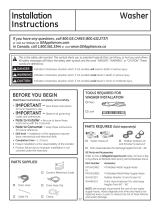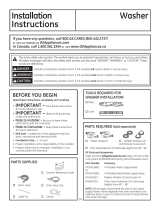
49-90576-3 19
Installation Instructions
LOCATION OF YOUR WASHER
DO NOT Install the Washer:
1. In an area exposed to dripping water or outside
weather conditions. The ambient temperature should
never be below 60°F (15.6°C) for proper washer
operation.
2. In an area where it will come in contact with curtains or
drapes.
3. On carpet. The floor MUST be a hard surface with a
PD[LPXPVORSHRIƎSHUIRRWFPSHUFP
To make sure the washer does not vibrate or move,
you may have to reinforce the floor.
NOTE:,IIORRULVLQSRRUFRQGLWLRQXVHƎLPSUHJQDWHG
plywood sheet solidly attached to existing floor covering.
IMPORTANT: Minimum Installation Clearances
- Alcove or Closet
• If your washer is approved for installation in an alcove or
closet, there will be a label on the back of the machine
describing requirements.
• Minimum clearance between washer and adjacent walls
or other surfaces: 0" either side, 2" front, 3" rear.
Vertical space from floor to overhead shelving, cabinets,
ceiling, etc. = 60".
• Closet doors must be louvered or otherwise ventilated
and have at least 60 square inches of open area. If the
closet contains both a washer and a dryer, doors must
contain a minimum of 120 square inches of
open area.
NOTE: The clearances stated on this label are minimums.
Consideration must be given to providing adequate
clearances for installing and servicing.
After the machine is in the home, remove outside
packing material/carton from washer.
Remove bag (containing clamp, cable tie and drain
hose clip), drain hose and Owner's Reference Guide
from tub.
NOTE: Leave foam shipping material inside tub
opening to hold tub in place during the rest of
installation.
1
UNPACKING THE WASHER
Remove base from unit by placing foot on side of base
and tipping unit back on corner post. Remove base and
bring the washer back upright.
2
REMOVE THE BASE
WATER SUPPLY REQUIREMENTS
WATER SUPPLY LINES - Purge Hot and Cold water supply lines for 30 seconds prior to installation of hoses and washing
machine. Ensure inlet hose screens are also clean and free of debris.
WATER PRESSURE - Must be 20 psi minimum to 120 psi maximum.
WATER TEMPERATURE - Household water heater should be set to deliver water at 120° to 150°F (50° to 66°C) TO THE
WASHER when hot wash is selected.
SHUTOFF VALVES - Both hot and cold shutoff valves (faucets) should be supplied.
DRAIN - Water should be drained into standpipe. Discharge height MUST NOT BE LESS THAN 30 INCHES, and no
more than 8 feet above the base of the washer. Standpipe must be 1-1/2 inches minimum inside diameter and must
be open to atmosphere.
Bag
Owner's Reference Guide
Leave foam shipping
material inside tub
Drain hose
Certain internal parts are intentionally not grounded
and may present a risk of electric shock only during
servicing.
Service personnel – DO NOT contact the following
parts while the appliance is energized: Drive Motor,
Lid Lock, Water Valves, Drain Pump and Recirculation
Pump.
- Electrical Shock Hazard
WARNING





















